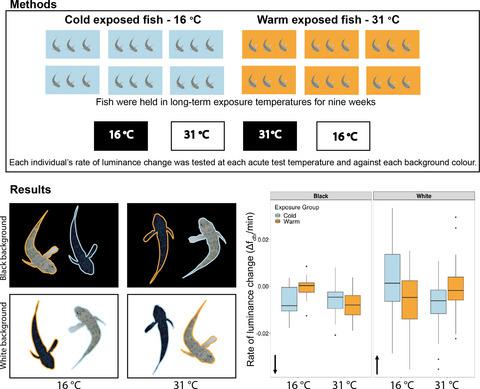当前位置:
X-MOL 学术
›
J. Anim. Ecol.
›
论文详情
Our official English website, www.x-mol.net, welcomes your feedback! (Note: you will need to create a separate account there.)
Intertidal gobies acclimate rate of luminance change for background matching with shifts in seasonal temperature
Journal of Animal Ecology ( IF 4.8 ) Pub Date : 2020-04-13 , DOI: 10.1111/1365-2656.13226 Carmen R B da Silva 1, 2 , Cedric P van den Berg 1 , Nicholas D Condon 3 , Cynthia Riginos 1 , Robbie S Wilson 1 , Karen L Cheney 1, 4
Journal of Animal Ecology ( IF 4.8 ) Pub Date : 2020-04-13 , DOI: 10.1111/1365-2656.13226 Carmen R B da Silva 1, 2 , Cedric P van den Berg 1 , Nicholas D Condon 3 , Cynthia Riginos 1 , Robbie S Wilson 1 , Karen L Cheney 1, 4
Affiliation

|
Rate of colour change and background matching capacity are important functional traits for avoiding predation and hiding from prey. Acute changes in environmental temperature are known to impact the rate at which animals change colour, and therefore may affect their survival. Many ectotherms have the ability to acclimate performance traits such as locomotion, metabolic rate and growth rate with changes in seasonal temperature. However, it is unclear how other functional traits that are directly linked to behaviour and survival respond to long-term changes in temperature (within an individual's lifetime). We assessed whether the rate of colour change is altered by long-term changes in temperature (seasonal variation) and if rate of colour change can acclimate to seasonal thermal conditions. We used an intertidal rock-pool goby, Bathygobius cocosensis, to test this and exposed individuals to representative seasonal mean temperatures (16 ºC or 31 ºC, herein referred to cold and warm-exposed fish, respectively) for nine weeks and then tested their rate of luminance change when placed on white and black backgrounds at acute test temperatures 16 ºC and 31 ºC. We modelled rate of luminance change using the visual sensitives of a coral trout (Plectropmus leopardus) to determine how well gobies matched their backgrounds in terms of luminance contrast to a potential predator. After exposure to long-term seasonal conditions, the warm-exposed fish had faster rates of luminance change and matched their background more closely when tested at 31 ºC than at 16 ºC. Similarly, the cold-exposed fish had faster rates of luminance change and matched their backgrounds more closely at 16 ºC than at 31 ºC. This demonstrates that rate of luminance change can be adjusted to compensate for long-term changes in seasonal temperature. This is the first study to show that animals can acclimate rate of colour change for background matching to seasonal thermal conditions. We also show that rapid changes in acute temperature reduce background matching capabilities. Stochastic changes in climate are likely to affect the frequency of predator-prey interactions which may have substantial knock-on effects throughout ecosystems.
中文翻译:

潮间带虾虎鱼适应季节温度变化背景匹配亮度变化率
颜色变化率和背景匹配能力是避免捕食和躲避猎物的重要功能特征。众所周知,环境温度的急剧变化会影响动物变色的速度,因此可能会影响它们的生存。许多变温动物具有适应性能特征的能力,例如随季节温度变化的运动、代谢率和生长率。然而,目前尚不清楚与行为和生存直接相关的其他功能特征如何对温度的长期变化(在个人一生中)做出反应。我们评估了颜色变化率是否因温度的长期变化(季节性变化)而改变,以及颜色变化率是否可以适应季节性热条件。我们使用了潮间带岩池虾虎鱼,Bathygobius cocosensis,为了测试这一点,并将个体暴露在具有代表性的季节性平均温度(16 ºC 或 31 ºC,这里分别指冷和暖暴露的鱼)下九周,然后测试它们放置在白色和黑色上时的亮度变化率急性试验温度 16 ºC 和 31 ºC 下的背景。我们使用珊瑚鳟鱼 (Plectropmus leopardus) 的视觉敏感度对亮度变化率进行建模,以确定虾虎鱼与潜在捕食者的亮度对比与其背景的匹配程度。在长期暴露于季节性条件后,与 16 ºC 相比,在 31 ºC 下测试时,暴露在温暖环境中的鱼的亮度变化速度更快,并且与它们的背景更接近。相似地,与 31 ºC 相比,冷暴露的鱼在 16 ºC 下亮度变化速度更快,并且与背景更接近。这表明可以调整亮度变化率以补偿季节性温度的长期变化。这是第一项表明动物可以适应颜色变化率的研究,以适应与季节性热条件相匹配的背景。我们还表明,急性温度的快速变化会降低背景匹配能力。气候的随机变化可能会影响捕食者-猎物相互作用的频率,这可能会对整个生态系统产生重大的连锁反应。这是第一项表明动物可以适应颜色变化率的研究,以适应与季节性热条件相匹配的背景。我们还表明,急性温度的快速变化会降低背景匹配能力。气候的随机变化可能会影响捕食者-猎物相互作用的频率,这可能会对整个生态系统产生重大的连锁反应。这是第一项表明动物可以适应颜色变化率的研究,以适应与季节性热条件相匹配的背景。我们还表明,急性温度的快速变化会降低背景匹配能力。气候的随机变化可能会影响捕食者-猎物相互作用的频率,这可能会对整个生态系统产生重大的连锁反应。
更新日期:2020-04-13
中文翻译:

潮间带虾虎鱼适应季节温度变化背景匹配亮度变化率
颜色变化率和背景匹配能力是避免捕食和躲避猎物的重要功能特征。众所周知,环境温度的急剧变化会影响动物变色的速度,因此可能会影响它们的生存。许多变温动物具有适应性能特征的能力,例如随季节温度变化的运动、代谢率和生长率。然而,目前尚不清楚与行为和生存直接相关的其他功能特征如何对温度的长期变化(在个人一生中)做出反应。我们评估了颜色变化率是否因温度的长期变化(季节性变化)而改变,以及颜色变化率是否可以适应季节性热条件。我们使用了潮间带岩池虾虎鱼,Bathygobius cocosensis,为了测试这一点,并将个体暴露在具有代表性的季节性平均温度(16 ºC 或 31 ºC,这里分别指冷和暖暴露的鱼)下九周,然后测试它们放置在白色和黑色上时的亮度变化率急性试验温度 16 ºC 和 31 ºC 下的背景。我们使用珊瑚鳟鱼 (Plectropmus leopardus) 的视觉敏感度对亮度变化率进行建模,以确定虾虎鱼与潜在捕食者的亮度对比与其背景的匹配程度。在长期暴露于季节性条件后,与 16 ºC 相比,在 31 ºC 下测试时,暴露在温暖环境中的鱼的亮度变化速度更快,并且与它们的背景更接近。相似地,与 31 ºC 相比,冷暴露的鱼在 16 ºC 下亮度变化速度更快,并且与背景更接近。这表明可以调整亮度变化率以补偿季节性温度的长期变化。这是第一项表明动物可以适应颜色变化率的研究,以适应与季节性热条件相匹配的背景。我们还表明,急性温度的快速变化会降低背景匹配能力。气候的随机变化可能会影响捕食者-猎物相互作用的频率,这可能会对整个生态系统产生重大的连锁反应。这是第一项表明动物可以适应颜色变化率的研究,以适应与季节性热条件相匹配的背景。我们还表明,急性温度的快速变化会降低背景匹配能力。气候的随机变化可能会影响捕食者-猎物相互作用的频率,这可能会对整个生态系统产生重大的连锁反应。这是第一项表明动物可以适应颜色变化率的研究,以适应与季节性热条件相匹配的背景。我们还表明,急性温度的快速变化会降低背景匹配能力。气候的随机变化可能会影响捕食者-猎物相互作用的频率,这可能会对整个生态系统产生重大的连锁反应。


























 京公网安备 11010802027423号
京公网安备 11010802027423号